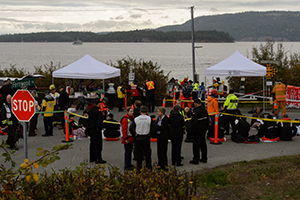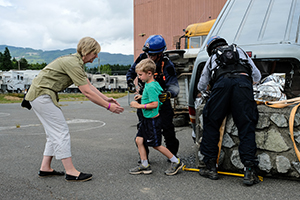Provincial emergency exercise program
The goal of the emergency exercise program is to support emergency exercise activity throughout the province. This includes First Nations, local, provincial, and federal agencies working with our team, or independently, to prepare for emergencies.
On this page
About emergency exercises
An exercise is a simulated emergency in which people perform the tasks that would be expected of them to prepare for a real emergency. Exercises can be used for learning, practicing, or trying new processes.
There are several types of activity that can be considered an exercise. For example, a seminar to train new staff, or to examine new procedures, can be considered an exercise. A workshop can help to produce a new plan for a certain type of emergency. A tabletop exercise for staff can help them practice their roles in an emergency. More complicated full scale exercises are conducted as staff become more proficient.
The Exercise team can help plan any of these exercises and has some sample exercises (below) for a workshop and a tabletop exercise that anyone is welcome to use.
Work with the exercise team
The Exercise team plans a minimum of 2 regional exercises per year, a Provincial level exercise every 2 years, and a large scale catastrophic all-hazard emergency exercise every 5 years. We also assist the rest of government for their Ministry Operation Centre exercises.
The team will also assist local, municipal and First Nations exercises via the EMCR regions on a case by case basis.
Support is tailored to organizational needs and can include assistance with planning, design, scenario development, conduct, and evaluation. There is no cost for this exercise assistance.
If you have questions, please email the exercise program staff at EMBC.Exercises@gov.bc.ca and include "Exercise Support Question" in your subject line.
Exercise tools and resources
Here are some resources that anyone can use to run their own seminars, workshops and exercises.
We recommend begining by reading the Justice of Institute BC (JIBC) quick reference guide: exercise design (1). It explains the different types of exercises available and provides introductory knowledge of some important terms and the steps to completing an exercise.
We've provided an example of a Workshop PowerPoint (2) that can be downloaded and modified to meet user needs. This particular workshop can be used by community planners to examine their evacuation procedures in order to be better prepared.
A Table-top exercise (3) is also available for use. An emergency operation centre can use this to practice procedures for an emergency. Again, users are welcome to download and modify these assets to meet your specific needs. The exercise includes an accompanying Facilitator Guide (4), and a Participant Manual (5) which people at the exercise can use to make notes to refer to in the future.
- JIBC quick reference guide: Exercise Design (PDF)
- Evacuation Workshop (PPTX, 1.6MB)
This is a generic evacuation workshop that emergency managers can use to prepare their organizations for evacuation scenarios - Community Evacuation Table-top Exercise PowerPoint (PPTX, 1.8MB)
- Community Evacuation Table-top Exercise Facilitator Guide (DOC, 13.7MB)
- Community Evacuation Table-top Exercise Participant Manual (DOC, 129KB)
Emergency exercise events
Upcoming response exercises and events in British Columbia are in our exercise calendar. It's
Past major exercises
Coastal Response 2023
Exercise Coastal Response was a full scale provincial and national exercise held from February 7 to 9, 2023. It was co-led by the province and Public Safety Canada and took place primarily in Victoria and the Lower Mainland. It also involved participation of national-level emergency operations centres and provincial emergency operations centres outside of the simulated affected area.
Read the Joint Federal/Provincial After Action Report (PDF, 1.2MB).
What was the scenario?
On February 3, 2023, a simulated 6.8 magnitude earthquake occurred approximately 12 kilometers northwest of Tsawwassen, B.C. with no tsunami. Serious damage was reported in Greater Vancouver and strong aftershocks were felt. The event caused widespread damage to critical infrastructure, and older buildings and structures. Casualties were significant with many killed and injured. Thousands of people were also displaced from their homes. The exercise commenced on February 7 (+96 hours from the first quake) in order to allow for a period of self-recovery to occur, allowing emergency operations centres to be operational and to be able to concentrate on consequence management tasks with a coordinated provincial and federal response.
What was the purpose of this exercise?
The purpose of the exercise was to practice prioritization strategy, coordination, and communication through an integrated whole of government response to a catastrophic B.C. earthquake event.
There were 6 overarching exercise objectives which were also closely aligned with federal objectives:
- Continuity of government / business continuity: Identify, develop, and test government/business continuity and succession planning at all levels
- Critical infrastructure / damage assessment: Practice prioritization for the restoration of critical infrastructure
- Logistics: Practice and validate evolving provincial logistics concept of support, to operationalize Section 8 of the Provincial Earthquake Immediate Response Strategy (PEIRS)
- Strategic decision making: Practice decision-making, communication, and coordination for complex issues requiring immediate action to reduce disaster risk
- Strategic communications: Conduct joint communications and engagement, with a focus on consistency of public information
- Mass care: Develop / practice mass care response concepts
The exercise involved the participation of emergency operations centres (EOCs) represented by– municipal, regional, provincial, First Nations, federal government, select private sector, and non-governmental organizations. Each EOC activated and staffed their respective operations to manage disaster response structures within their respective jurisdictions while simultaneously coordinating with other EOCs and departments/agencies to meet exercise objectives.
Salish Sea 2017
On October 25 and 26, 2017, Exercise Salish Sea took place in the waters off Saltspring Island, British Columbia.
What was the scenario?
 The scenario for the October 25th exercise found a fire on board the BC Ferry M/V Coastal Renaissance – it was of such severity that an evacuation of all passengers was required. The Search and Rescue phase of the exercise involved 97 live actors who evacuated from the ferry via the evacuation slide system; they were then transported ashore by marine resources and triaged ashore by Emergency Health Services. An additional 57 live actors on the island were given makeup to simulate the injuries they may have suffered, adding realism for those ashore providing initial medical care.
The scenario for the October 25th exercise found a fire on board the BC Ferry M/V Coastal Renaissance – it was of such severity that an evacuation of all passengers was required. The Search and Rescue phase of the exercise involved 97 live actors who evacuated from the ferry via the evacuation slide system; they were then transported ashore by marine resources and triaged ashore by Emergency Health Services. An additional 57 live actors on the island were given makeup to simulate the injuries they may have suffered, adding realism for those ashore providing initial medical care.
On October 26 the simulation continued, with CCGS Bartlett playing the part of the ferry casualty, with on-water training and boom deployment, and the activation of an Incident Command Post with almost 100 participants from multiple federal, provincial and non-government agencies, as well as BC Ferries and other industry representatives performing key roles. This second phase is what made this exercise unique, in that this was the first time that an exercise tested not only the search and rescue phase of the response to such an event, but also the environmental response phase, while engaging public and private industry reps under one Unified Command.
What was the purpose of this exercise?
The objective of the largest ever exercise in the Canadian Pacific was twofold: to validate and modernize the Pacific Joint Rescue Coordination Centre (JRCC) Major Marine Disaster plan; and to demonstrate the Maritime Safety and Environmental response system to First Nations and local governments as an introduction to many of the initiatives and potential partnerships that will emerge from the Ocean Protection Plan (OPP). The 2-day event tested and promoted interoperability between the Canadian Coast Guard (CCG), Department of National Defence, the Province of British Columbia and many local B.C. communities. The close relationships built during the planning the exercise resulted in an exercise that enhanced the effectiveness of a whole of government response to a major maritime disaster.
Exercise Coastal Response 2016
Exercise Coastal Response was held on June 7-10, 2016, in the Port Alberni region. Read the Initial Findings from Exercise Coastal Response report (PDF) for more information.
What was the scenario?
 It was B.C.'s first ever full-scale earthquake and tsunami response exercise. Exercise Coastal Response 2016 was based on a magnitude 9.0 earthquake resulting from a rupture of the Cascadia Subduction Zone off the coast of southwestern B.C. In this exercise scenario, strong shaking lasting several minutes would occur in areas of Greater Vancouver, Greater Victoria and central Vancouver Island, causing some destruction in the major urban centres and widespread damage in the Port Alberni valley. The earthquake would also generate a tsunami on the west coast of Vancouver Island minutes after the initial shock.
It was B.C.'s first ever full-scale earthquake and tsunami response exercise. Exercise Coastal Response 2016 was based on a magnitude 9.0 earthquake resulting from a rupture of the Cascadia Subduction Zone off the coast of southwestern B.C. In this exercise scenario, strong shaking lasting several minutes would occur in areas of Greater Vancouver, Greater Victoria and central Vancouver Island, causing some destruction in the major urban centres and widespread damage in the Port Alberni valley. The earthquake would also generate a tsunami on the west coast of Vancouver Island minutes after the initial shock.
What was the purpose of this exercise?
A strong and effective provincial response to a catastrophic earthquake hinges on B.C.’s ability to coordinate with internal and external agencies at all levels. The purpose of Exercise Coastal Response 2016 was for Emergency Management BC to bring together some key stakeholder groups – multiple levels of government, various jurisdictions in Canada and the U.S., and a number of provincial ministries, First Nations, Crown corporations and first responders – in a coordinated and integrated way to activate the B.C. Earthquake Immediate Response Plan (PDF). The goal was to exercise elements of this plan and strengthen relationships among and across partners and stakeholders to enhance operational coordination.
